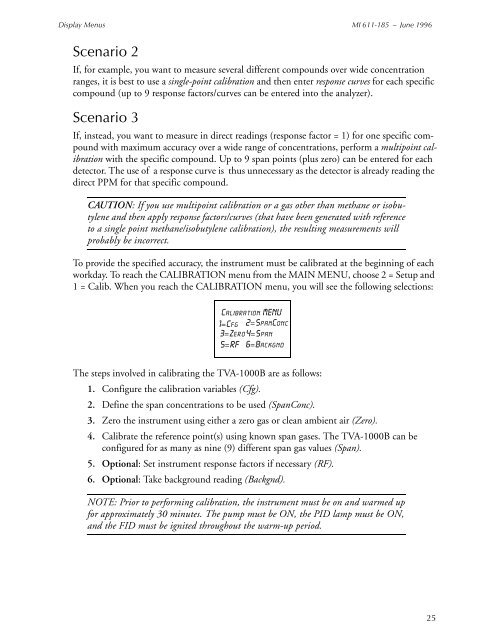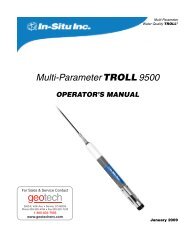Thermo Scientific TVA-1000B Instruction Manual - Geotech ...
Thermo Scientific TVA-1000B Instruction Manual - Geotech ...
Thermo Scientific TVA-1000B Instruction Manual - Geotech ...
Create successful ePaper yourself
Turn your PDF publications into a flip-book with our unique Google optimized e-Paper software.
Display Menus MI 611-185 – June 1996<br />
Scenario 2<br />
If, for example, you want to measure several different compounds over wide concentration<br />
ranges, it is best to use a single-point calibration and then enter response curves for each specific<br />
compound (up to 9 response factors/curves can be entered into the analyzer).<br />
Scenario 3<br />
If, instead, you want to measure in direct readings (response factor = 1) for one specific compound<br />
with maximum accuracy over a wide range of concentrations, perform a multipoint calibration<br />
with the specific compound. Up to 9 span points (plus zero) can be entered for each<br />
detector. The use of a response curve is thus unnecessary as the detector is already reading the<br />
direct PPM for that specific compound.<br />
CAUTION: If you use multipoint calibration or a gas other than methane or isobutylene<br />
and then apply response factors/curves (that have been generated with reference<br />
to a single point methane/isobutylene calibration), the resulting measurements will<br />
probably be incorrect.<br />
To provide the specified accuracy, the instrument must be calibrated at the beginning of each<br />
workday. To reach the CALIBRATION menu from the MAIN MENU, choose 2 = Setup and<br />
1 = Calib. When you reach the CALIBRATION menu, you will see the following selections:<br />
Calibration MENU<br />
1=Cfg 2=SpanConc<br />
3=Zero 4=Span<br />
5=RF 6=Backgnd<br />
The steps involved in calibrating the <strong>TVA</strong>-<strong>1000B</strong> are as follows:<br />
1. Configure the calibration variables (Cfg).<br />
2. Define the span concentrations to be used (SpanConc).<br />
3. Zero the instrument using either a zero gas or clean ambient air (Zero).<br />
4. Calibrate the reference point(s) using known span gases. The <strong>TVA</strong>-<strong>1000B</strong> can be<br />
configured for as many as nine (9) different span gas values (Span).<br />
5. Optional: Set instrument response factors if necessary (RF).<br />
6. Optional: Take background reading (Backgnd).<br />
NOTE: Prior to performing calibration, the instrument must be on and warmed up<br />
for approximately 30 minutes. The pump must be ON, the PID lamp must be ON,<br />
and the FID must be ignited throughout the warm-up period.<br />
25

















